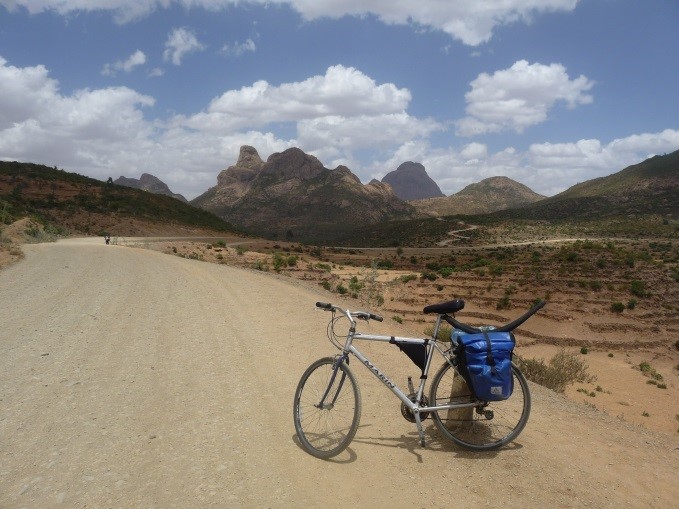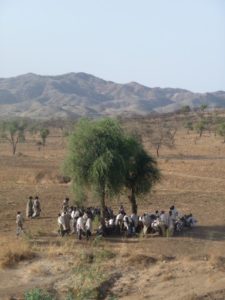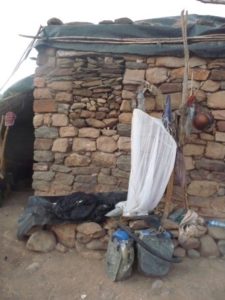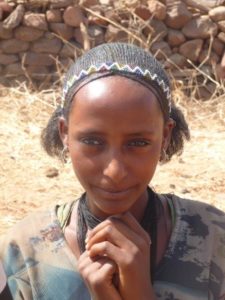Andy Bottomer - Perfect Endurance
Click here to go to Andy's full length feature blog!
‘A Biblical Famine in the 20th Century’
The Addis Ababa ‘Food Run’ was my reason to cycle in Ethiopia. Jill and Gary Campbell were the impetus behind it. They had been VSO volunteers in Ethiopia and had never left. Jill had been a primary teacher at Sandford International School for over ten years and I had just joined as Head of PE. The project has a safe house, provides food, clothing and medical support to homeless people. They make people aware of the plight of the homeless in many ways including taking school children and sponsors out on the ‘Food Run’ to see the reality. I had been out with Jill one wet night shortly after I arrived. The boots of two taxis were full of hot meals and bottles of water. We drove around areas Jill knew people would be sleeping. It was a pretty depressing and haunting sight with rows of plastic wrapped bodies under bridges and on roadside verges. Cold but grateful hands came out from inside makeshift houses and there was always a thank you. Sometimes the bodies didn’t stir so I left the bag close enough to smell. I wondered what reaction these people would have waking up to a meal or going to sleep with a full stomach. The basic human right of food and shelter was missing here and it upset me. That night as I lay in my warm bed I decided I would support Jill’s efforts where I could. My idea was a north to south sponsored cycle through Ethiopia.
This section of the cycle is from Axum to Sekota through the heart of Northern Ethiopia. Cath dropped me at the airport at 5 am on a cold morning. I knew this was going to be a tough but amazing week. On the flight I deliberately didn’t look out the window because the thought of cycling back filled me with some trepidation to be honest. In the Axum airport car park I slowly put my bike together. A man asked if he could have the box for his chickens. My chain had got tangled and the same man fixed it for me. I was ready but first wanted to see the holiest city of the Ethiopian Orthodox Church, Axum. I was in Tigray, Ethiopia’s northernmost state where the country’s remarkable civilisation was born and nurtured. Earliest legends and records date back at least 3000 years. It was from Axum that the fabled Queen of Sheba travelled to Jerusalem to meet Solomon and returned ‘with all his wisdom’ and his baby. Further legend has it that their son Menekik later travelled to Jerusalem and brought back the fabled Ark of the Covenant. Ethiopian belief is the Ark lies in Axum to this day but nobody has ever been allowed to witness or verify this. Axum was the capital of the mighty Axumite Empire. Ethiopian tradition accepts the belief that Christianity was adopted by King Ezzana during his rule at the height of the Axumite power. I stayed long enough to stare in wonderment at the slightly tilting 23 metre high stele accredited to King Ezzana. It has no religious significance just a power thing. He was probably compensating for the lack of something. It is a solid block of engraved granite with a carved door and nine windows. As millions of people before me I wondered ‘how did they do that?’ In the back streets I managed to enter the grounds of the Cathedral of Tsion Maryam. A church was first constructed there in the 4th century. Nothing old remains today accept the church that Emperor Fasilidas built around 1640. The old parts of Axum like the new parts are covered in scaffolding. The most ancient city in Ethiopia is still being built. It was all too fascinating but I hadn’t the time. A sign post put Axum 1026 kilometres by tarmac road from Addis. My route would be a different one and I needed to get moving.
A good 25 kilometre tarmac road runs east to Adwa. Adwa is the site of the 1896 Battle of Adwa where the Ethiopian army under Emperor Menelik II defeated the Italians, thereby ensuring that his empire was the only African state to enter the 20th century as a fully independent entity. This proudness remains to this day amongst Ethiopians.

The Road From Adwa to Mai Kenetal
I passed through some neat Tigray villages made of solid stone. It is very hot, dusty and I’m tired. After 65 kilometres Mai Kenetal comes just in time. I get a flannel wash, beer and an injera meal. I feel better and find a room. I slept for almost ten hours and was woken by the 5 am ‘call to prayer’ from the nearby mosque. I was sore and my legs heavy but I’m soon revived by a big egg sandwich and some homemade cheese rolls. The cheese has melted but is still vacuum-packed thankfully. Hot sweaty cheese in fresh hot bread is great even after another sweaty 50 kilometres deep in my bag. I’m soon at the edge of a ridge and there is a great view down. I was soon enjoying a down to the river valley. However experience and basic geography tells me there will be an up soon. At the bridge it is so quiet. The next three hours are brutal as I push up over three ridges through deep sand at times. I’m in good spirits so the kids don’t bother me much. The landscape is rocky and dry with few trees to shade under.

An almost Biblical Scene
At 6 am I’m up and ready with a great hangover. It is 15 kilometres on the Mekele road before I turn off. The recent history of this road to Sekota filled me full of thoughts and dread. In 1984-85 so many starving people had walked out along this road to Sekota. Only then did the world take notice. I’m heading for Yechila, the first sizeable town on this road. The road gently rolls up and down and I make good time. It is a quiet ride with very few people around. Yechila is a little oasis and I refuel with injera and water. It is a strange feeling to know where I’m headed but I have to leave. Finarwe is a small junction village with another road that goes to Mekele. The real lowlands are coming as I head down towards Abergele. The soil is a red colour and nothing seems to be growing. I have just left Tigray and am now in the Amhara region.
Abergele is notoriously famed as the epicentre of the 1984-85 famine. At the time the Derg government was spending half its national budget on the war in Tigray. Add to this disastrous agricultural policies and years of drought. I was a bit haunted by the thought of thousands of starving people walking this road I was cycling to get out. I didn’t know enough really and vowed to find out more on my return. It happened 28 years ago and I couldn’t help looking at that age group and wondering how life had started for them. Back in Addis I would watch the October 1984 Michael Buerk BBC report from Korem. He described it as ‘a biblical famine in the 20th century’ and ‘the closest thing to hell on earth’. He described how 40,000 starving people (15,000 of them children) had walked for days to get to Korem. He described how one person was dying every twenty minutes. It is estimated that over one million people died and over 8 million were affected by the famine. The Derg government of the time knew of the chronic food shortages due to years of drought. It didn’t respond for political reasons because the area was a stronghold of the Tigray rebels who were fighting to overthrow the government. Their only response was to forcibly move 600,000 people to the south and attempt to force people into villages in an attempt to control the poor security situation. It just made matters worse. That 1984 BBC report stirred Bob Geldof and the UK public to donate over £5 million in 3 days. Massive amounts of aid money arrived in Ethiopia. I read a BBC report from 2010 which was later retracted that claimed over $100 million of aid money was misused by the Tigray rebels to buy weapons. I had tears in my eyes.
That hot afternoon in Abergele I sat and had a quiet drink. I couldn’t get the famine out of my head. 28 years on I thought could a similar human tragedy happen again in a country with chronic food insecurity and over 11 million people on constant food aid. It is happening though on a smaller scale and my thoughts turned to the ‘Food Run’ and the reason why I was cycling. I wasn’t sure where I was going to spend the night but it wasn’t here. I reached the Tserari River by 4 pm and decide this is the place. The altitude is 1200 metres above sea level. There is a water pump by the river and the land has been irrigated with mangoes, tomatoes and onions growing. I sat on a bridge and wondered where I might sleep.
Habti came to talk to me and he said I could sleep at his house. I feel comfortable here and I enjoy a relaxed evening with his family. They all sit around using the light and music from his mobile phone for entertainment.
I decline the old injera offered me but still have a sweaty cheese roll from this morning. His wife makes ‘tela’ beer and people come to sit and drink. Unfortunately my bed is a stone bench where the drinkers sit. By 9 pm and after lots of exaggerated yawning the last drinker leaves and I try and sleep. That night the wind was fresh and it kept me cool. I woke early and get ready for the off. I give Habti my spare hat but he refused any money so I give it to his wife. I’m in the Agaw region of Amhara now. The young men all tend to wear green or blue shirts with long collars covered in white buttons. Some have matching shorts. The women I met were beautiful with neck tattoos and decorated head bands.
I’m greeted with a sunrise over the Tserari River and sadly eat my last cheese with some crackers. I follow the river up a green valley. The giving power of water here is obvious. It is slow progress but the scenery is amazing with strange and stunning mountains high above. I reached the village of Shakura at the foot of a huge escarpment. I knew what was coming and braced myself. In the village all the kids chased me and shouted for money and pens. A brand new school has been built but open next year a teacher sitting on a rock told me. It got hilly. I tried holding the back of a truck but the dust was too much and the pull too great. The road eventually levelled out. 35 kilometres is my best guess to Sekota. The final hill to Sekota was brutal but I made it.
Back in Addis Ababa I sat in our sunny flower filled garden. I added the final red line on my hand drawn map which had started out blank in August 2012. Now in October 2013 it had a thin red line running down the entire length of the country. I looked at it proudly and smiled to myself. I worked out I had cycled 981 kilometres in the north from Axum to Addis and 826 kilometres in the south from Addis to Omorate. Before the journey I had estimated it would be about 1800 kilometres so I was not far wrong. It had taken me six different trips over 23 days.
My overriding thought was my cycle had been a cross section through Ethiopia along one continuous road. I had seen a snapshot of life along that road. The physical and mental effort required to achieve it had in some small way given me some empathy and connection with the very tough lives people lead in Ethiopia, the country I had been living in for just over 3 years. As I wrote this it sounded a bit pathetic to think I could in any way empathise with the lives most Ethiopians live. Ethiopia is a very difficult place to connect with but I had tried. My journey had been primarily for me but I had also raised £3000 for homeless people in Addis and I felt good about that. The day I got back Jill invited me round for dinner and we went out on the ‘Food Run’. It seemed a fitting end to the cycle. It saddened me again to see so many people sleeping rough. Today I had my first proper meal, change of clothes and hot shower for 5 days. The people I gave food to tonight would continue their daily fight for food, shelter and would wake up in the same dirty clothes day after day for a long time to come. I admire Jill and Gary for their continued efforts to reach out to these people.


